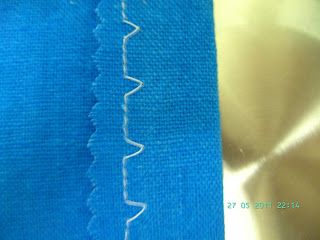"How to Do More With Your Blind-hem Foot! Part One: Blind-hemming"
One thing I love is versatility. Many presser feet are very versatile and one of these is the blind-hem foot. If you have an adjustable blind hem foot that is even better, but I have a fixed one. It came with my Brother XR6600. I have 5 uses for it including, of course, blind-hemming. The rest will be covered in the following posts and they are: pin-tucking, edge-stitching/top-stitching, stitching-in-the-ditch, and edge-joining.
Before you begin, you must attach your blind-hem foot. Yours may look a little different and may be adjustable, but this is mine. At the front you can see that it has a metal guide which goes underneath the foot, kinks in the middle for the needle, and then goes back to its regular path.
Use 1: Blind-hemming
When you blind hem by machine, it is not always absolutely invisible -- that is why I usually hem by hand. You will get instead, a little ladder stitch along the stitching line.
To begin, neaten the raw edge and then turn up the hem. (Photo at left.) Then fold it back on itself so that you have a sort of tuck on the RS and the neatened edge is pointing away from the garment. (Photo at right.)
Select the blind-hem stitch (number 9 below) on your machine, or the stretch blind-hem stitch (number 10 below) if you are using stretch fabric like jersey.
You may need to adjust the stitch width on your machine if you can to make sure the needle catches the fabric on the zigzag swing of the stitch. Secure the stitch or leave long thread tails to hand tie. Holding the thread tails neatly out of the way, start stitching. Keep the fold of the fabric butted up against the metal guide on the foot. When you get to the end, secure the stitch or leave long thread tails to tie.
When you have finished it will look like this: The first image is what it looks like when you remove it from your sewing machine; the second is what it looks like on the inside when you turn the hem to its correct position, and the third is what it looks like from the RS. If I had used a perfect colour match, it would have been less noticeable, but I used white thread because I had some of that.
The machine blind hem is good for people who have poor eyesight or have difficulty doing things with their hands, and for those who are in a hurry.
Well, that is the main use of the blind-hem foot, but as I said earlier, there is more. This post has got to be quite long, so I'll put the other uses on subsequent posts.
Until next time, happy sewing!
Sabrina Wharton-Brown
Labels: sewing











3 Comments:
Hi! I've just found your informative blog. I have been sewing for many, many years but still need the information you have been so kind to provide. My DIL wants me to teach her to sew but she lives over 6 hours away from me so I will be sending her your blog address. She can follow your excellent instructions and practice when she has time. Then when I visit we can have hands on with anything she has questions about.
Thank you again for such a wonderful, informative blog!
Hi Lynn! Thank you! Your comment made my day. :) I'm glad I can help.
Thanks,this is a great tutorial.
Post a Comment
Subscribe to Post Comments [Atom]
<< Home